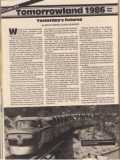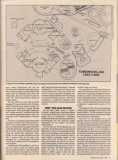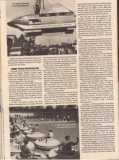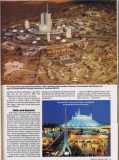"Welcome to the Disneyland Flight Circle Show, presented by the Wen-Mac Corporation, world's largest producer of action toys!"
These immortal words marked the beginning of the 15-minute Flight Circle model airplane show. A big, circular arena stood at the center of Tomorrowland, surrounded by a 10-foot-tall chain-link fence. The Disneyland Flight Crew flew miniature, gasoline powered Turbojet airplanes that whirled around and around the arena at speeds up to 35 miles an hour. Besides conducting the model airplane show, the Flight Crew also staged miniature speedboat races around a little lagoon at the arena's edge.
One of the most legendary Tomorrowland spectacles took place at the Flight Circle during the Christmas Season of 1965. The Bell Aerosystems Rocket Man strapped on his "Rocket Belt" and blasted off for a 30-second steam-powered flight over Tomorrowland. Three times a day, he deafened the crowd with the roar of his engine.
[…]
During the first year back in 1955, the Autopia and the Phantom Boats had been the only real "rides" in Tomorrowland. It became apparent that the guests wanted to do more than just walk through hallways and watch movies. Disneyland met the challenge the next summer with two new action attractions.
The Astrojets were the first of these new thrillers. Guests boarded rocket-like crafts emblazoned with exotic names like Canopus, Sirius, Antares and Castor. As the Astrojet tower began to rotate, hydraulic arms attached to the tower lifted the 12 rockets 36 feet into the air. The rockets climbed and dove under the individual control of their pilots.
If guests wanted to get even higher than the Astrojets, they could ride from Tomorrowland to Fantasyland aboard another European import, the brand-new Skyway. Dozens of circular aluminum buckets were suspended from a single moving cable that stretched across Disneyland. Inside each bucket sat two molded plastic patio chairs, their legs bolted to the floor.
Walt Disney considered the Skyway to be an experimental transportation system of the future, the first of many he would introduce at Disneyland. After its first year of operation, he was so pleased with the Skyway's popularity that he set out to create another experimental system, the "Train of Tomorrow."
Working closely with studio designers, engineers and machinists, Walt Disney developed the Viewliner – a sleek, all-aluminum train with fiberglass seats and big, open windows. It made its debut on June 26, 1957, circling the old, still-abandoned Phantom Boat lagoon.
[…]
But Disney had bigger dreams for his Tram of Tomorrow: he envisioned it raised up into the air atop a concrete "highway in the sky." Not a noisy, ugly elevated railroad like the ones in Eastern cities, but a single, elevated "beamway" with silent, all-electric monorail trains gliding along on rubber tires.
In 1958, Disney heard about a German company known as Alweg (named for the initials of its founder, Dr. Axel L. Wenner-Gren). They had developed exactly the train that Disney had in mind, and so he decided that the Alweg Monorail would be running at Disneyland the very next summer – less than seven months away!
[…]
The year 1959 saw many other dramatic changes in Tomorrowland as well. The abandoned Phantom Boat lagoon became the home of the Submarine Voyage through Liquid Space. Each of the eight submarines was "nuclear-powered" (with just a little help from a diesel engine) and together, they comprised the world's eighth largest submarine fleet.
Next door to the lagoon, giant Matterhorn Mountain towered over Tomorrowland – and over the whole country. In those early days, the Matterhorn was a major Southern California landmark, visible for miles. Inside the mountain, dozens of bobsleds careened along the world's full steel-track roller-coaster. For the first time, multiple cars could ride a coaster track at the same time, separated by a sophisticated electronic "block-zone" which never let two cars get too close together.
Following the 1959 expansion, a serious effort was made to give the already aging Tomorrowland a facelift. The Moonliner's red and white logo was traded in for the blue and white colors of Douglas Aircraft. The Bell Telephone System introduced "America the Beautiful," a brand-new Circarama tour of the United States. Next door, Space Station X-1 (which, somewhere along the way, had been renamed Satellite View of America) was removed to make room for "The Art of Animation," a collection of displays which explained the process of producing animated pictures.
1961: The Last Hurrah
By the early 1960s, many of Tomorrowland's original shows had been eclipsed by advanced technology and by the guests' higher level of expectation. Ironically, Disneyland itself had raised the standards of entertainment and was therefore largely responsible for the public's new found sophistication.
[…]
1966: Time catches up
Then came the fateful year of 1966. In just two short decades, Halley's Comet would return, and 1986 would be upon us. The Clock of the World had been ticking too fast. Time was catching up and Tomorrowland was falling behind – into the past.
So, in 1966, the world of 1986 was unceremoniously closed and demolished. Gone were the Moonliner, the giant aluminum telescope, the flying saucers – gone even, was the Clock of the World. And in that fateful year of 1966, Disneyland lost more than its dream of the future. On December 15, in a hospital room in Burbank, it lost the dreamer, Walt Disney.
In 1967, the seeds of vision that Walt Disney had planted sprouted again. With the next summer came a new land of tomorrow, and a new dream for the future. Tomorrowland was no longer proclaimed the world of 1986, but had instead, become the spawning for a new vision called EPCOT.
[…]
1986: and Beyond
And finally, as the comet approaches, the present catches up just in time to witness the beginnings of a spectacular new Tomorrowland. Before long, a fabulous Disneyland adventure will take off in the world of Star Wars. C-3PO, R2-D2, Darth Vader – and a few surprises – will all come to life and join the Disneyland cast of characters. It's only fitting that their never-before-seen adventures will take place aboard a brand new kind of ride – the next generation of Disney thrill attractions (already beginning construction).
The introduction of George Lucas' Star Wars mythology is a natural and fitting step for Disneyland. In fact, the introduction of a "non-Disney" mythology is nothing new; while there has never been a Disney film based on any of the Tom Sawyer and Huck Finn stories, they blend with Frontierland every bit as well as Dumbo in Fantasyland!
In the years to come, the limitless energy released by the joining of Walt Disney and George Lucas will lead to adventures beyond Disneyland, beyond Star Wars, and into our future, our past, even the realms of our own imagination!
The year 1986 has indeed proven to be a prophetic setting, a time to salute the past, and look to the future. Here's to the next 30 years – see you . . . Tomorrow!



